Deck 7: The Control of Microbial Growth
سؤال
سؤال
سؤال
سؤال
سؤال
سؤال
سؤال
سؤال
سؤال
سؤال
سؤال
سؤال
سؤال
سؤال
سؤال
سؤال
سؤال
سؤال
سؤال
سؤال
سؤال
سؤال
سؤال
سؤال
سؤال
سؤال
سؤال
سؤال
سؤال
سؤال
سؤال
سؤال
سؤال
سؤال
سؤال
سؤال
سؤال
سؤال
سؤال
سؤال
سؤال
سؤال
سؤال
سؤال
سؤال
سؤال
سؤال
سؤال
سؤال
سؤال
سؤال
سؤال
سؤال
سؤال
سؤال

فتح الحزمة
قم بالتسجيل لفتح البطاقات في هذه المجموعة!
Unlock Deck
Unlock Deck
1/55
العب
ملء الشاشة (f)
Deck 7: The Control of Microbial Growth
1
Which of the following methods is used to preserve food by slowing the metabolic processes of foodborne microbes?
A) ionizing radiation
B) nonionizing radiation
C) lyophilization
D) pasteurization
E) freezing
A) ionizing radiation
B) nonionizing radiation
C) lyophilization
D) pasteurization
E) freezing
E
2
Disinfection of water is achieved by all of the following EXCEPT
A) UV radiation.
B) chlorine.
C) peracetic acid.
D) copper sulfate.
E) ozone.
A) UV radiation.
B) chlorine.
C) peracetic acid.
D) copper sulfate.
E) ozone.
C
3
Which of the following could be used to sterilize plastic Petri plates in a plastic wrapper?
A) ultraviolet radiation
B) microwaves
C) sunlight
D) gamma radiation
E) autoclave
A) ultraviolet radiation
B) microwaves
C) sunlight
D) gamma radiation
E) autoclave
D
4
Which of the following substances is used for surgical hand scrubs?
A) soap
B) chlorhexidine
C) chlorine bleach
D) glutaraldehyde
E) phenol
A) soap
B) chlorhexidine
C) chlorine bleach
D) glutaraldehyde
E) phenol

فتح الحزمة
افتح القفل للوصول البطاقات البالغ عددها 55 في هذه المجموعة.
فتح الحزمة
k this deck
5
Application of heat to living cells can result in all of the following EXCEPT
A) alteration of membrane permeability.
B) breaking of hydrogen bonds.
C) denaturation of enzymes.
D) damage to nucleic acids.
E) decreased thermal death time.
A) alteration of membrane permeability.
B) breaking of hydrogen bonds.
C) denaturation of enzymes.
D) damage to nucleic acids.
E) decreased thermal death time.

فتح الحزمة
افتح القفل للوصول البطاقات البالغ عددها 55 في هذه المجموعة.
فتح الحزمة
k this deck
6
Which of the following results in lethal damage to nucleic acids?
A) heat
B) radiation
C) certain chemicals
D) heat and radiation
E) heat, radiation, and some chemicals
A) heat
B) radiation
C) certain chemicals
D) heat and radiation
E) heat, radiation, and some chemicals

فتح الحزمة
افتح القفل للوصول البطاقات البالغ عددها 55 في هذه المجموعة.
فتح الحزمة
k this deck
7
Which of the following is a limitation of the autoclave?
A) It cannot be used with glassware.
B) It requires an excessively long time to achieve sterilization.
C) It cannot kill endospores.
D) It cannot inactivate viruses.
E) It cannot be used with heat- labile materials.
A) It cannot be used with glassware.
B) It requires an excessively long time to achieve sterilization.
C) It cannot kill endospores.
D) It cannot inactivate viruses.
E) It cannot be used with heat- labile materials.

فتح الحزمة
افتح القفل للوصول البطاقات البالغ عددها 55 في هذه المجموعة.
فتح الحزمة
k this deck
8
Figure 7.1
A suspension of 106 Bacillus cereus endospores was put in a hot- air oven at 170°C. Plate counts were used to determine the number of endospores surviving at the time intervals shown.
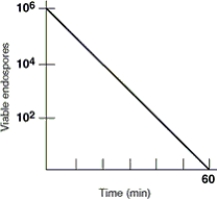
In Figure 7.1, what is the thermal death time?
A) 120 minutes
B) 100°C
C) 60 minutes
D) 150°C
E) The answer cannot be determined based on the information provided.
A suspension of 106 Bacillus cereus endospores was put in a hot- air oven at 170°C. Plate counts were used to determine the number of endospores surviving at the time intervals shown.

In Figure 7.1, what is the thermal death time?
A) 120 minutes
B) 100°C
C) 60 minutes
D) 150°C
E) The answer cannot be determined based on the information provided.

فتح الحزمة
افتح القفل للوصول البطاقات البالغ عددها 55 في هذه المجموعة.
فتح الحزمة
k this deck
9
Which of the following best describes the pattern of microbial death?
A) All the cells in a culture die at once.
B) The cells in a population die at a constant rate.
C) The pattern varies depending on the species.
D) The pattern varies depending on the antimicrobial agent.
E) Not all of the cells in a culture are killed.
A) All the cells in a culture die at once.
B) The cells in a population die at a constant rate.
C) The pattern varies depending on the species.
D) The pattern varies depending on the antimicrobial agent.
E) Not all of the cells in a culture are killed.

فتح الحزمة
افتح القفل للوصول البطاقات البالغ عددها 55 في هذه المجموعة.
فتح الحزمة
k this deck
10
Figure 7.1
A suspension of 106 Bacillus cereus endospores was put in a hot- air oven at 170°C. Plate counts were used to determine the number of endospores surviving at the time intervals shown.
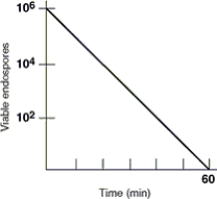
In Figure 7.1, the decimal reduction time (D value) for the culture is approximately
A) 0 minutes.
B) 10 minutes.
C) 30 minutes.
D) 40 minutes.
E) 60 minutes.
A suspension of 106 Bacillus cereus endospores was put in a hot- air oven at 170°C. Plate counts were used to determine the number of endospores surviving at the time intervals shown.

In Figure 7.1, the decimal reduction time (D value) for the culture is approximately
A) 0 minutes.
B) 10 minutes.
C) 30 minutes.
D) 40 minutes.
E) 60 minutes.

فتح الحزمة
افتح القفل للوصول البطاقات البالغ عددها 55 في هذه المجموعة.
فتح الحزمة
k this deck
11
If you were preparing nutrient agar at home and did not have an autoclave, what could you use to sterilize the nutrient agar?
A) boiling for one hour
B) hydrogen peroxide
C) pressure cooker at 121°C for 15 minutes
D) oven at 121°C for one hour
E) bleach
A) boiling for one hour
B) hydrogen peroxide
C) pressure cooker at 121°C for 15 minutes
D) oven at 121°C for one hour
E) bleach

فتح الحزمة
افتح القفل للوصول البطاقات البالغ عددها 55 في هذه المجموعة.
فتح الحزمة
k this deck
12
Figure 7.2
Assume 109 E. coli cells/ml are in a flask.

Which graph in Figure 7.2 best depicts the effect of placing the culture at 7°C at time x?
A) a
B) b
C) c
D) d
E) e
Assume 109 E. coli cells/ml are in a flask.

Which graph in Figure 7.2 best depicts the effect of placing the culture at 7°C at time x?
A) a
B) b
C) c
D) d
E) e

فتح الحزمة
افتح القفل للوصول البطاقات البالغ عددها 55 في هذه المجموعة.
فتح الحزمة
k this deck
13
All of the following factors contribute to hospital- acquired infections EXCEPT
A) some bacteria metabolize disinfectants.
B) bacteria may be present in commercial products such as mouthwash.
C) invasive procedures can provide a portal of entry for bacteria.
D) gram- negative bacteria are often resistant to disinfectants.
E) None of the answers is correct; all of these factors may contribute to hospital- acquired infection.
A) some bacteria metabolize disinfectants.
B) bacteria may be present in commercial products such as mouthwash.
C) invasive procedures can provide a portal of entry for bacteria.
D) gram- negative bacteria are often resistant to disinfectants.
E) None of the answers is correct; all of these factors may contribute to hospital- acquired infection.

فتح الحزمة
افتح القفل للوصول البطاقات البالغ عددها 55 في هذه المجموعة.
فتح الحزمة
k this deck
14
All of the following substances are used to preserve foods EXCEPT
A) potassium sorbate.
B) biguanides.
C) sodium nitrite.
D) calcium propionate.
E) nisin.
A) potassium sorbate.
B) biguanides.
C) sodium nitrite.
D) calcium propionate.
E) nisin.

فتح الحزمة
افتح القفل للوصول البطاقات البالغ عددها 55 في هذه المجموعة.
فتح الحزمة
k this deck
15
Which one of the following is most resistant to chemical biocides?
A) gram- negative bacteria
B) viruses with lipid envelopes
C) protozoan cysts
D) mycobacteria
E) gram- positive bacteria
A) gram- negative bacteria
B) viruses with lipid envelopes
C) protozoan cysts
D) mycobacteria
E) gram- positive bacteria

فتح الحزمة
افتح القفل للوصول البطاقات البالغ عددها 55 في هذه المجموعة.
فتح الحزمة
k this deck
16
The preservation of beef jerky from microbial growth relies on which method of microbial control?
A) ionizing radiation
B) filtration
C) lyophilization
D) desiccation
E) supercritical CO2
A) ionizing radiation
B) filtration
C) lyophilization
D) desiccation
E) supercritical CO2

فتح الحزمة
افتح القفل للوصول البطاقات البالغ عددها 55 في هذه المجموعة.
فتح الحزمة
k this deck
17
Which of the following disinfectants acts by disrupting the plasma membrane?
A) heavy metals
B) soaps
C) bisphenols
D) halogens
E) aldehydes
A) heavy metals
B) soaps
C) bisphenols
D) halogens
E) aldehydes

فتح الحزمة
افتح القفل للوصول البطاقات البالغ عددها 55 في هذه المجموعة.
فتح الحزمة
k this deck
18
Oxidizing agents include all of the following EXCEPT
A) ozone.
B) hydrogen peroxide.
C) chlorine.
D) glutaraldehyde.
E) iodine.
A) ozone.
B) hydrogen peroxide.
C) chlorine.
D) glutaraldehyde.
E) iodine.

فتح الحزمة
افتح القفل للوصول البطاقات البالغ عددها 55 في هذه المجموعة.
فتح الحزمة
k this deck
19
Which of the following regarding antimicrobial control agents is FALSE?
A) Some agents are utilized as both an antiseptic and a disinfectant.
B) A true antimicrobial control agent is equally effective against both bacteria and viruses.
C) Contaminating organic debris such as blood or sputum will decrease effectiveness.
D) Some agents kill by denaturing microbial cell proteins.
E) Some agents affect microbial cell membranes by dissolving lipids.
A) Some agents are utilized as both an antiseptic and a disinfectant.
B) A true antimicrobial control agent is equally effective against both bacteria and viruses.
C) Contaminating organic debris such as blood or sputum will decrease effectiveness.
D) Some agents kill by denaturing microbial cell proteins.
E) Some agents affect microbial cell membranes by dissolving lipids.

فتح الحزمة
افتح القفل للوصول البطاقات البالغ عددها 55 في هذه المجموعة.
فتح الحزمة
k this deck
20
Which of the following treatments is the most effective for controlling microbial growth?
A) 63°C for 30 minutes
B) 72°C for 15 seconds
C) 140°C for 4 seconds
D) They are equivalent treatments.
E) None of the answers is correct.
A) 63°C for 30 minutes
B) 72°C for 15 seconds
C) 140°C for 4 seconds
D) They are equivalent treatments.
E) None of the answers is correct.

فتح الحزمة
افتح القفل للوصول البطاقات البالغ عددها 55 في هذه المجموعة.
فتح الحزمة
k this deck
21
Which concentration of ethanol is the most effective bactericide?
A) 100 percent
B) 70 percent
C) 50 percent
D) 40 percent
E) 30 percent
A) 100 percent
B) 70 percent
C) 50 percent
D) 40 percent
E) 30 percent

فتح الحزمة
افتح القفل للوصول البطاقات البالغ عددها 55 في هذه المجموعة.
فتح الحزمة
k this deck
22
Figure 7.2
Assume 109 E. coli cells/ml are in a flask.

Which graph in Figure 7.2 best depicts the effect of placing the culture in an autoclave for 15 minutes at time x?
A) a
B) b
C) c
D) d
E) e
Assume 109 E. coli cells/ml are in a flask.

Which graph in Figure 7.2 best depicts the effect of placing the culture in an autoclave for 15 minutes at time x?
A) a
B) b
C) c
D) d
E) e

فتح الحزمة
افتح القفل للوصول البطاقات البالغ عددها 55 في هذه المجموعة.
فتح الحزمة
k this deck
23
All of the following substances are effective against nonenveloped viruses EXCEPT
A) chlorine.
B) ethylene oxide.
C) ozone.
D) alcohol.
E) None of the answers is correct; all of these are equally effective against nonenveloped viruses.
A) chlorine.
B) ethylene oxide.
C) ozone.
D) alcohol.
E) None of the answers is correct; all of these are equally effective against nonenveloped viruses.

فتح الحزمة
افتح القفل للوصول البطاقات البالغ عددها 55 في هذه المجموعة.
فتح الحزمة
k this deck
24
An agent used to reduce the number of bacteria on a toilet would most accurately be called a(n)
A) virucide.
B) disinfectant.
C) fungicide.
D) antiseptic.
E) aseptic.
A) virucide.
B) disinfectant.
C) fungicide.
D) antiseptic.
E) aseptic.

فتح الحزمة
افتح القفل للوصول البطاقات البالغ عددها 55 في هذه المجموعة.
فتح الحزمة
k this deck
25
Ethylene oxide
A) requires high heat to be effective.
B) is the active chemical in household bleach.
C) is a sterilizing agent.
D) is a good antiseptic.
E) is not sporicidal.
A) requires high heat to be effective.
B) is the active chemical in household bleach.
C) is a sterilizing agent.
D) is a good antiseptic.
E) is not sporicidal.

فتح الحزمة
افتح القفل للوصول البطاقات البالغ عددها 55 في هذه المجموعة.
فتح الحزمة
k this deck
26
Which of the following pairs is mismatched?
A) ultraviolet radiation - desiccation
B) supercritical fluids - CO2
C) ionizing radiation - hydroxyl radicals
D) plasma sterilization - free radicals
E) ozone - takes electrons from substances
A) ultraviolet radiation - desiccation
B) supercritical fluids - CO2
C) ionizing radiation - hydroxyl radicals
D) plasma sterilization - free radicals
E) ozone - takes electrons from substances

فتح الحزمة
افتح القفل للوصول البطاقات البالغ عددها 55 في هذه المجموعة.
فتح الحزمة
k this deck
27
The antimicrobial activity of chlorine is due to which of the following?
A) the formation of a hypochlorite ion
B) the formation of hydrochloric acid
C) disruption of the plasma membrane
D) the formation of ozone
E) the formation of hypochlorous acid
A) the formation of a hypochlorite ion
B) the formation of hydrochloric acid
C) disruption of the plasma membrane
D) the formation of ozone
E) the formation of hypochlorous acid

فتح الحزمة
افتح القفل للوصول البطاقات البالغ عددها 55 في هذه المجموعة.
فتح الحزمة
k this deck
28
Which of the following chemical agents is used for sterilization?
A) alcohol
B) phenolics
C) soap
D) chlorine
E) ethylene oxide
A) alcohol
B) phenolics
C) soap
D) chlorine
E) ethylene oxide

فتح الحزمة
افتح القفل للوصول البطاقات البالغ عددها 55 في هذه المجموعة.
فتح الحزمة
k this deck
29
Table 7.3
The following data were obtained by incubating gram- positive bacteria in nutrient medium + disinfectant for 24 hr, then transferring one loopful to nutrient medium (subculturing). (+ = growth; - = no growth)
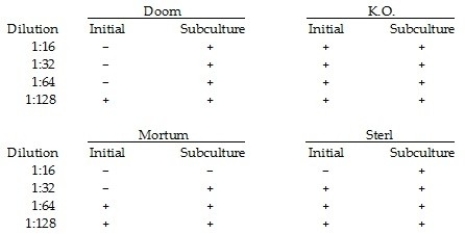
In Table 7.3, which disinfectant was most effective against Salmonella?
A) K.O.
B) Sterl
C) Doom
D) Mortum
E) The answer cannot be determined based on the information provided.
The following data were obtained by incubating gram- positive bacteria in nutrient medium + disinfectant for 24 hr, then transferring one loopful to nutrient medium (subculturing). (+ = growth; - = no growth)

In Table 7.3, which disinfectant was most effective against Salmonella?
A) K.O.
B) Sterl
C) Doom
D) Mortum
E) The answer cannot be determined based on the information provided.

فتح الحزمة
افتح القفل للوصول البطاقات البالغ عددها 55 في هذه المجموعة.
فتح الحزمة
k this deck
30
All of the following are effective for destroying prions EXCEPT
A) NaOH + autoclaving at 134°C.
B) incineration.
C) proteases.
D) boiling.
E) None of the answers are correct; each of these will destroy prions.
A) NaOH + autoclaving at 134°C.
B) incineration.
C) proteases.
D) boiling.
E) None of the answers are correct; each of these will destroy prions.

فتح الحزمة
افتح القفل للوصول البطاقات البالغ عددها 55 في هذه المجموعة.
فتح الحزمة
k this deck
31
Table 7.3
The following data were obtained by incubating gram- positive bacteria in nutrient medium + disinfectant for 24 hr, then transferring one loopful to nutrient medium (subculturing). (+ = growth; - = no growth)

In Table 7.3, which disinfectant was bactericidal?
A) Doom
B) Sterl
C) K.O.
D) Mortum
E) The answer cannot be determined based on the information provided.
The following data were obtained by incubating gram- positive bacteria in nutrient medium + disinfectant for 24 hr, then transferring one loopful to nutrient medium (subculturing). (+ = growth; - = no growth)

In Table 7.3, which disinfectant was bactericidal?
A) Doom
B) Sterl
C) K.O.
D) Mortum
E) The answer cannot be determined based on the information provided.

فتح الحزمة
افتح القفل للوصول البطاقات البالغ عددها 55 في هذه المجموعة.
فتح الحزمة
k this deck
32
Table 7.2
The fate of E. coli O157:H7 in apple cider held at 8°C for 2 weeks, with and without preservatives, is shown below:
-In Table 7.2, which preservative is most effective?
A) potassium sorbate
B) sodium benzoate
C) potassium sorbate + sodium benzoate
D) no preservative
The fate of E. coli O157:H7 in apple cider held at 8°C for 2 weeks, with and without preservatives, is shown below:
-In Table 7.2, which preservative is most effective?
A) potassium sorbate
B) sodium benzoate
C) potassium sorbate + sodium benzoate
D) no preservative

فتح الحزمة
افتح القفل للوصول البطاقات البالغ عددها 55 في هذه المجموعة.
فتح الحزمة
k this deck
33
Which of the following does NOT achieve sterilization?
A) supercritical fluids
B) dry heat
C) ethylene oxide
D) pasteurization
E) autoclave
A) supercritical fluids
B) dry heat
C) ethylene oxide
D) pasteurization
E) autoclave

فتح الحزمة
افتح القفل للوصول البطاقات البالغ عددها 55 في هذه المجموعة.
فتح الحزمة
k this deck
34
Table 7.3
The following data were obtained by incubating gram- positive bacteria in nutrient medium + disinfectant for 24 hr, then transferring one loopful to nutrient medium (subculturing). (+ = growth; - = no growth)
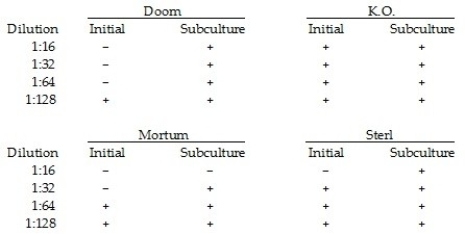
In Table 7.3, which disinfectant is the most effective at stopping bacterial growth?
A) Doom
B) K.O.
C) Mortum
D) Sterl
E) The answer cannot be determined based on the information provided.
The following data were obtained by incubating gram- positive bacteria in nutrient medium + disinfectant for 24 hr, then transferring one loopful to nutrient medium (subculturing). (+ = growth; - = no growth)

In Table 7.3, which disinfectant is the most effective at stopping bacterial growth?
A) Doom
B) K.O.
C) Mortum
D) Sterl
E) The answer cannot be determined based on the information provided.

فتح الحزمة
افتح القفل للوصول البطاقات البالغ عددها 55 في هذه المجموعة.
فتح الحزمة
k this deck
35
Which of the following pairs is mismatched?
A) alcohols - open wounds
B) H2O2 - open wounds
C) CuSO4 - algicide
D) organic acids - food preservation
E) Ag - wound dressings
A) alcohols - open wounds
B) H2O2 - open wounds
C) CuSO4 - algicide
D) organic acids - food preservation
E) Ag - wound dressings

فتح الحزمة
افتح القفل للوصول البطاقات البالغ عددها 55 في هذه المجموعة.
فتح الحزمة
k this deck
36
Bone and tendons for transplant are decontaminated by
A) ethylene oxide.
B) plasma sterilization.
C) glutaraldehyde.
D) supercritical fluids.
E) peroxygens.
A) ethylene oxide.
B) plasma sterilization.
C) glutaraldehyde.
D) supercritical fluids.
E) peroxygens.

فتح الحزمة
افتح القفل للوصول البطاقات البالغ عددها 55 في هذه المجموعة.
فتح الحزمة
k this deck
37
All of the following are methods of food preservation EXCEPT
A) osmotic pressure.
B) microwaves.
C) high pressure.
D) ionizing radiation.
E) desiccation.
A) osmotic pressure.
B) microwaves.
C) high pressure.
D) ionizing radiation.
E) desiccation.

فتح الحزمة
افتح القفل للوصول البطاقات البالغ عددها 55 في هذه المجموعة.
فتح الحزمة
k this deck
38
Which of the following regarding antimicrobial control agents is FALSE?
A) Contaminating organic debris such as blood or sputum decrease effectiveness.
B) Some agents inactivate viruses by attacking cell membrane lipids.
C) Some agents affect microbial cell membranes by dissolving lipids.
D) Some agents kill by denaturing microbial cell proteins.
E) Silver is used for treating antibiotic- resistant bacteria.
A) Contaminating organic debris such as blood or sputum decrease effectiveness.
B) Some agents inactivate viruses by attacking cell membrane lipids.
C) Some agents affect microbial cell membranes by dissolving lipids.
D) Some agents kill by denaturing microbial cell proteins.
E) Silver is used for treating antibiotic- resistant bacteria.

فتح الحزمة
افتح القفل للوصول البطاقات البالغ عددها 55 في هذه المجموعة.
فتح الحزمة
k this deck
39
Which of the following is the best method to sterilize heat- labile solutions?
A) freezing
B) membrane filtration
C) dry heat
D) pasteurization
E) autoclave
A) freezing
B) membrane filtration
C) dry heat
D) pasteurization
E) autoclave

فتح الحزمة
افتح القفل للوصول البطاقات البالغ عددها 55 في هذه المجموعة.
فتح الحزمة
k this deck
40
Figure 7.1
A suspension of 106 Bacillus cereus endospores was put in a hot- air oven at 170°C. Plate counts were used to determine the number of endospores surviving at the time intervals shown.
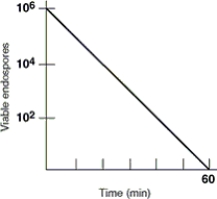
In Figure 7.1, the thermal death point for this culture is
A) 15 minutes.
B) 50°C.
C) 170°C.
D) 30 minutes.
E) The answer cannot be determined based on the information provided
A suspension of 106 Bacillus cereus endospores was put in a hot- air oven at 170°C. Plate counts were used to determine the number of endospores surviving at the time intervals shown.

In Figure 7.1, the thermal death point for this culture is
A) 15 minutes.
B) 50°C.
C) 170°C.
D) 30 minutes.
E) The answer cannot be determined based on the information provided

فتح الحزمة
افتح القفل للوصول البطاقات البالغ عددها 55 في هذه المجموعة.
فتح الحزمة
k this deck
41
An iodophor is a(n)
A) agent that reduces oxygen.
B) form of formaldehyde.
C) phenol.
D) iodine mixed with a surfactant.
E) quaternary ammonium compound.
A) agent that reduces oxygen.
B) form of formaldehyde.
C) phenol.
D) iodine mixed with a surfactant.
E) quaternary ammonium compound.

فتح الحزمة
افتح القفل للوصول البطاقات البالغ عددها 55 في هذه المجموعة.
فتح الحزمة
k this deck
42
Desiccation is a reliable form of sterilization.

فتح الحزمة
افتح القفل للوصول البطاقات البالغ عددها 55 في هذه المجموعة.
فتح الحزمة
k this deck
43
Autoclaving is the most effective method of moist heat sterilization.

فتح الحزمة
افتح القفل للوصول البطاقات البالغ عددها 55 في هذه المجموعة.
فتح الحزمة
k this deck
44
Moist heat destroys organisms by denaturing proteins.

فتح الحزمة
افتح القفل للوصول البطاقات البالغ عددها 55 في هذه المجموعة.
فتح الحزمة
k this deck
45
Table 7.4
The results below were obtained from a use- dilution test of two disinfectants.
Cultures were inoculated into tubes with varying concentrations of disinfectants
and incubated for 24 hr at 20°C, then subcultured in nutrient media without disinfectants. (+ = growth; - = no growth)

In Table 7.4, what is the minimal bacteriostatic concentration of each disinfectant? Which compound is bactericidal? At what concentration?
The results below were obtained from a use- dilution test of two disinfectants.
Cultures were inoculated into tubes with varying concentrations of disinfectants
and incubated for 24 hr at 20°C, then subcultured in nutrient media without disinfectants. (+ = growth; - = no growth)

In Table 7.4, what is the minimal bacteriostatic concentration of each disinfectant? Which compound is bactericidal? At what concentration?

فتح الحزمة
افتح القفل للوصول البطاقات البالغ عددها 55 في هذه المجموعة.
فتح الحزمة
k this deck
46
Some antimicrobial chemicals are considered to be disinfectants and antiseptics.

فتح الحزمة
افتح القفل للوصول البطاقات البالغ عددها 55 في هذه المجموعة.
فتح الحزمة
k this deck
47
Which of the following pairs of terms is mismatched?
A) sterilant - destroys all living microorganisms
B) bacteriostatic - kills vegetative bacterial cells
C) fungicide - kills yeasts and molds
D) germicide - kills microbes
E) virucide - inactivates viruses
A) sterilant - destroys all living microorganisms
B) bacteriostatic - kills vegetative bacterial cells
C) fungicide - kills yeasts and molds
D) germicide - kills microbes
E) virucide - inactivates viruses

فتح الحزمة
افتح القفل للوصول البطاقات البالغ عددها 55 في هذه المجموعة.
فتح الحزمة
k this deck
48
The pH of the medium has no effect on the activity of the disinfectant being applied.

فتح الحزمة
افتح القفل للوصول البطاقات البالغ عددها 55 في هذه المجموعة.
فتح الحزمة
k this deck
49
Ultraviolet light (UV) causes irreversible breaks in DNA strands.

فتح الحزمة
افتح القفل للوصول البطاقات البالغ عددها 55 في هذه المجموعة.
فتح الحزمة
k this deck
50
Any process that destroys the non- spore forming contaminants on inanimate objects is sterilization.

فتح الحزمة
افتح القفل للوصول البطاقات البالغ عددها 55 في هذه المجموعة.
فتح الحزمة
k this deck
51
Table 7.5
The following results were obtained from a use- dilution test of two disinfectants.
Cultures were inoculated into tubes containing varying concentrations of the disinfectants, incubated for 10 min. at 20°C, and then transferred to growth media without disinfectant. (+ = growth; - = no growth)
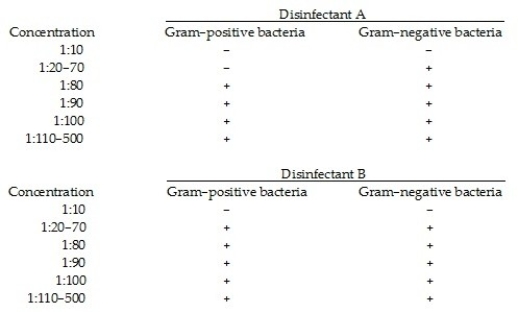
In Table 7.5, which disinfectant is most effective? Against which group of bacteria is Disinfectant A most effective?
The following results were obtained from a use- dilution test of two disinfectants.
Cultures were inoculated into tubes containing varying concentrations of the disinfectants, incubated for 10 min. at 20°C, and then transferred to growth media without disinfectant. (+ = growth; - = no growth)

In Table 7.5, which disinfectant is most effective? Against which group of bacteria is Disinfectant A most effective?

فتح الحزمة
افتح القفل للوصول البطاقات البالغ عددها 55 في هذه المجموعة.
فتح الحزمة
k this deck
52
Pseudomonas has been found growing in quaternary ammonium compounds (quats).

فتح الحزمة
افتح القفل للوصول البطاقات البالغ عددها 55 في هذه المجموعة.
فتح الحزمة
k this deck
53
The thermal death time is the time needed to kill all the bacteria in a particular culture at a certain temperature.

فتح الحزمة
افتح القفل للوصول البطاقات البالغ عددها 55 في هذه المجموعة.
فتح الحزمة
k this deck
54
Why must most milk sold in the U.S. be refrigerated at all times while evaporated canned milk and milk in cardboard containers sold in Europe do not need to be refrigerated until they are opened?

فتح الحزمة
افتح القفل للوصول البطاقات البالغ عددها 55 في هذه المجموعة.
فتح الحزمة
k this deck
55
Microorganisms placed in high concentrations of salts and sugars undergo lysis.

فتح الحزمة
افتح القفل للوصول البطاقات البالغ عددها 55 في هذه المجموعة.
فتح الحزمة
k this deck








